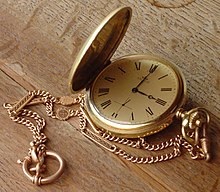 |
| An old fashioned
watch. |
Time
Time is the never-ending continued progress of existence
and events. It happens in an apparently irreversible way
from the past, through the present to the future.
To measure time, we can use anything that repeats itself
regularly. One example is the start of a new day (as
Earth rotates on its axis). Two more are the phases of
the moon (as it orbits the Earth), and the seasons of
the year (as the Earth orbits the Sun).
Even in ancient times, people developed calendars to
keep track of the number of days in a year. They also
developed sundials that used the moving shadows cast by
the sun through the day to measure times smaller than a
day. Today, highly accurate clocks can measure time in
less than a billionth of a second. The study of time
measurement is known as horology.
The SI (International Systems of Units) unit of time is
one second, written as s. When used as a variable in
mathematics, time is often represented by the symbol t.
In Einsteinian physics, time and space can be combined
into a single concept. For more on the topic, see
space-time continuum. |
|
|
Units of time |
- 1
millennium = 10 centuries = 100 decades = 200
lustrums = 250 quadrenniums = 333.33 trienniums =
500 bienniums = 1,000 years
- 1 century
= 10 decades = 20 lustrums = 25 quadrenniums = 33.33
trienniums = 50 bienniums = 100 years
- 1 decade
= 2 lustrums = 2.5 quadrenniums = 3.33 trienniums =
5 bienniums = 10 years
- 1 year
= 12 months = 52 weeks = 365 days (366 days in leap
years)
- 1 month
= 4 weeks = 2 fortnights = 28 to 31 days
- 1
fortnight = 2 weeks = 14 days
- 1 week
= 7 days
- 1 day
= 24 hours
- 1 hour
= 60 minutes
- 1 minute
= 60 seconds
- 1 second
= SI base unit of time
- 1
millisecond = 1/1,000 second
- 1
microsecond = 1/1,000,000 second
- 1
nanosecond = 1/1,000,000,000 second
- 1
picosecond = 1/1,000,000,000,000 of a second
- 1
femtosecond = 1/1,000,000,000,000,000 of a
second
- 1
attosecond = 1/1,000,000,000,000,000,000 of a
second
- 1 Planck
time = smallest measurable unit of time
|
|